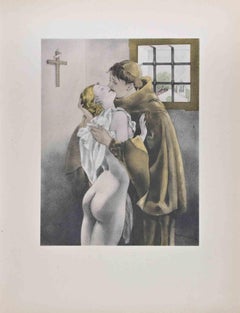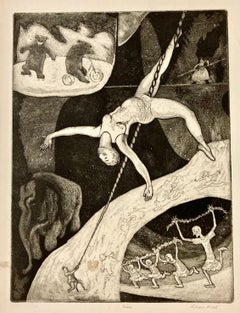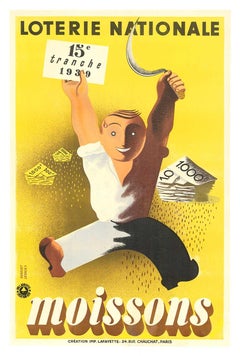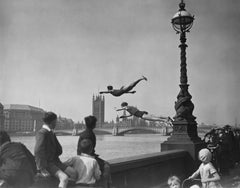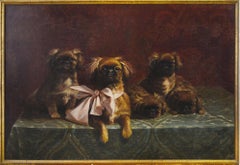1930s Art
to
1,032
3,394
1,187
891
515
332
Overall Width
to
Overall Height
to
7,533
21,062
158,004
233,768
1,955
2,247
4,841
6,367
5,780
13,183
19,484
25,641
17,913
13,689
5,365
2,454
480
367
225
127
108
101
67
12
12
5
2
2
3,488
2,364
314
3,835
1,721
1,618
1,134
1,105
715
457
439
428
367
356
318
290
285
269
258
225
222
214
192
1,982
1,521
1,324
1,146
853
261
105
90
83
61
1,713
1,148
3,285
2,666
Period: 1930s
Les Amants - Lithograph by Umberto Brunelleschi - 1930s
Located in Roma, IT
Les Amants is a color lithograph on ivory paper, realized by the Italian artist Umberto Brunelleschi (Montemurlo 1879- Paris 1949).
...
Category
Art Nouveau 1930s Art
Materials
Lithograph
William P. Hicks, Circus
Located in New York, NY
William P. Hicks has drawn everything about the circus that will fit in the plate. The main figure is an aerial act with a woman balancing on rope held by a figure on the floor. Ther...
Category
American Modern 1930s Art
Materials
Etching
Original MOISSONS (harvest) Loterie Nationale 1939 vintage French poster
Located in Spokane, WA
MOISSON (harvest) Loterie Nationale original 1939 lithograph Artwork by Edgar Derouet (1910-2001) and Charles Lesacq (1909-1940). size 15" x 23", year 1939. Archival linen backed i...
Category
Art Deco 1930s Art
Materials
Lithograph
Thames Divers (1934) - Silver Gelatin Fibre Print
Located in London, GB
Thames Divers (1934) - Silver Gelatin Fibre Print
(Photo by H F Davis/Getty Images Archive)
Two divers jumping off the Embankment into the River Thames in London, near Westminster...
Category
Modern 1930s Art
Materials
Black and White, Silver Gelatin
Pekingese Family of Dogs - Oil on Canvas by F.V. Rossi - 1939
By Filiberto Vitaliano Rossi
Located in Roma, IT
Pekingese Family of Dogs is an original artwork realized in 1939 by Filiberto Vitaliano Rossi.
Original oil on canvas.
Hand-signed and dated on the lower right corner.
Good conditions, except for some micro-holes on the canvas, very thin.
Beautiful artwork representing several Pekingese dogs...
Category
1930s Art
Materials
Oil
Sunflower Floral Arrangement - French 1930's Art Deco flower oil painting
Located in Hagley, England
This vibrant French Art Deco floral oil painting is by noted French artist Jacques Emile Blanche. Painted circa 1930, the palette is of wonderful tones of yellow and orange with spla...
Category
Art Deco 1930s Art
Materials
Oil
Deco Femme
Located in West Hollywood, CA
Our Gallery acquired the estate of a Northern California artist, Thelma Terrell. Terrell lived in Oakland and was an illustrator and profes...
Category
Art Deco 1930s Art
Materials
Mixed Media, Paper
Bust of Josephine Baker, Mid-Century Ceramic Female Face
By Vally Wieselthier
Located in Beachwood, OH
Attributed to Vally Wieselthier (Austrian-American, 1895-1945)
Bust of Josephine Baker, c. 1930
Ceramic
Stamped on base
11.5 x 5.5 x 5.5 inches
Vally Wieselthier (1895 Vienna--1945 ...
Category
1930s Art
Materials
Ceramic
Harmony, 20th century bronze & green marble base, nude man and woman with lyre
By Max Kalish
Located in Beachwood, OH
Max Kalish (American, 1891-1945)
Harmony, c. 1930
Bronze with green marble base
Incised signature on right upper side of base
14 x 9 x 5 inches, excluding base
17 x 10 x 8 inches, including base
Born in Poland March 1, 1891, figurative sculptor Max Kalish came to the United States in 1894, his family settling in Ohio. A talented youth, Kalish enrolled at the Cleveland Institute of Art as a fifteen-year-old, receiving a first-place award for modeling the figure during studies with Herman Matzen. Kalish went to New York City following graduation, studying with Isidore Konti...
Category
American Modern 1930s Art
Materials
Marble, Bronze
The Railway Station
Located in Los Angeles, CA
The Railway Station, c. 1934, oil on canvas, signed lower right, titled verso and noted "34"; illustrated Kaufman, Jeffrey, Brush with Life: The Art of Being Edward Biberman...
Category
American Modern 1930s Art
Materials
Oil
1930s Cheerful Watercolor of a Chicago Street Scene by Constantine Pougialis
Located in Chicago, IL
A 1930s cheerful & colorful watercolor depicting a Chicago Street scene by artist Constantine Pougialis. Image size: 15" x 22". Painting bears its original frame, which measures 21...
Category
American Modern 1930s Art
Materials
Paper, Watercolor
Early 20th Century Redwood Forest Sunset Reflections Landscape
Located in Soquel, CA
Early 20th Century Redwood Forest Sunset Reflections Landscape
Beautiful early 20th century landscape of sunset over redwood forest stream by William Lemos (American, 1861-1942). A ...
Category
Tonalist 1930s Art
Materials
Oil
Original Passion Play Oberammergau Tercentenary 1634 - 1934 vintage poster
By Jupp Wiertz
Located in Spokane, WA
Original Passion Play Tercentenary Oberammergau, 300th-year anniversary poster (1634 - 1934). "Germany Invites You!" This archivally linen-backed poster is the English version. It fe...
Category
Art Deco 1930s Art
Materials
Lithograph
Italian City (Cubist cityscape)
Located in Wilton Manors, FL
Karl Drerup (1904-2000). Italian City, c.1930. Oil on masonite panel, 24 x 32 inches; 34 x 42 in custom frame. Signed lower right. Minor conservation to loss in margins.
Price on request
Biography:
Born in Borghorst, Germany in 1904, Karl Drerup earned a Master’s Degree in graphic arts working under Hans Meid...
Category
Cubist 1930s Art
Materials
Oil, Panel
"Chrysler Building" Leon Dolice, New York City Street Scene, Mid-Century
By Leon Dolice
Located in New York, NY
Leon Dolice
Chrysler Building
Signed lower right
Watercolor on paper
19 x 12 inches
The romantic backdrop of Vienna at the turn of the century had a life-long influence upon the yo...
Category
American Modern 1930s Art
Materials
Pastel, Paper
“Sailboat at Sunset”
Located in Southampton, NY
Original large scale oil painting on board of a large sailing ship in sunset. The artist is Frederick Leo Hunter. Signed by the artist lower right and dated 1933. Condition is goo...
Category
Post-Impressionist 1930s Art
Materials
Oil, Fiberboard
Pablo Picasso, The Three Musicians, from Chroniques du Jour, 1930 (after)
Located in Southampton, NY
This exquisite lithograph and pochoir after Pablo Picasso (1881–1973), titled Les Trois Musiciens (The Three Musicians), from the album, Pablo Picasso, 1930, originates from the 1930...
Category
Cubist 1930s Art
Materials
Lithograph, Stencil
$2,396 Sale Price
20% Off
Cahiers d'art, Surrealist Composition 1
By Joan Miró
Located in Fairlawn, OH
Cahiers d'art, Surrealist Composition 1
Pochoir, 1934
Unsigned as issued in Cahier's edition
Published in Cahier's d'art, 1934
Unsigned Edition of 1200
There was also a pencil signed...
Category
Surrealist 1930s Art
Materials
Stencil
"Aeropittura " Tecnica mista su carta di giornale , cm. 43 x 59 1930
Located in Torino, IT
Aerei ,rosso ,blu,carta di giornale -La Stampa -
Siglato in basso a destra M.
L'opera viene venduta con certificato di autenticità dell'archivio Michele Falanga - Messina - Italia
M...
Category
Futurist 1930s Art
Materials
Mixed Media, Newsprint
Antique American Modernist SunFlower Still Life Framed Landscape Oil Painting
Located in Buffalo, NY
Antique American school modernist still life painting. Oil on board. Signed. Framed. In excellent original condition. Handsomely framed in a gold giltwood molding. Excellent c...
Category
Modern 1930s Art
Materials
Oil, Board
Landscape - Oil Painting by Armando Cermignani - 1930
Located in Roma, IT
Oil on plywood realized by Armando Cermignani (1888-1957) in 1930s.
Hand signed and dated.
Excellent condition.
Armando Cermignani was an Italian painter, engraver, ceramist and p...
Category
Modern 1930s Art
Materials
Oil
Vintage portrait of a woman sewing by french artist Leon Garraud
Located in AIGNAN, FR
A quiet moment captured by the artist, Leon Garraud of a woman sewing. It's an oil on board framed under glass in beautiful tones of browns and greys highlighed by the light shining...
Category
French School 1930s Art
Materials
Oil
"Winter Sunlight"
Located in Lambertville, NJ
Jim’s of Lambertville Fine Art Gallery is proud to present this piece by Walter Emerson Baum (1884 - 1956).
Born in Sellersville, Pennsylvania, Walter Baum was one of the only membe...
Category
American Impressionist 1930s Art
Materials
Canvas, Oil
Landscape in Haute Loire - French Impressionist Hay Bale Oil on Canvas Painting
Located in Sevenoaks, GB
A beautiful 1930's French impressionist oil on canvas depicting a landscape in the Haute Loire region with hay bale and hilltop village, by René Aubert.
...
Category
Impressionist 1930s Art
Materials
Canvas, Oil
In the Art Gallery, Early 20th Century Watercolor, Women Viewing Painting
Located in Beachwood, OH
Jules Andre Smith (American, 1880-1959)
In the Art Gallery, 1936
Watercolor and pen and ink
Signed Andre Smith, 1936 lower right
10.75 x 8.5 inches
20.25 x 17.25 inches, framed
Jule...
Category
1930s Art
Materials
Pen, Ink, Watercolor
'The Visitor' — Surrealist Fantasy
Located in Myrtle Beach, SC
Zena Kavin, 'The Visitor', lithograph, c. 1935, edition 20. Signed, titled, and numbered '9/20' in pencil. A fine, richly-inked impression, on cream wove paper, with full margins (7/...
Category
American Modern 1930s Art
Materials
Lithograph
Downtown New York
Located in Los Angeles, CA
Downtown New York, c. 1930s, oil on canvas, signed lower right, 10 x 12 inches; label verso reads: "Harry Dix / Title Downtown New York / Medium Oil"
Harry Dix was a 20th-century p...
Category
American Modern 1930s Art
Materials
Canvas, Oil
Sun Beams Into Grand Central Station (1930) - Silver Gelatin Fibre Print
Located in London, GB
Sun Beams Into Grand Central Station (1930) - Silver Gelatin Fibre Print
(Photo by Hal Morey/Getty Images)
Beams of sunlight streaming through the windows ...
Category
Modern 1930s Art
Materials
Black and White, Silver Gelatin
Reclined Nude - Drawing by Mino Maccari - 1930s
By Mino Maccari
Located in Roma, IT
Pencil drawing on paper realized by Mino Maccari in 1930s.
Hand signed lower right.
Very good condition.
Category
Modern 1930s Art
Materials
Charcoal, Watercolor
Icart, Composition, Le Sopha (after)
By Louis Icart
Located in Southampton, NY
La pointe sèche etching on vélin de Rives filigrané à notre nom paper. Paper size: 9.5 x 7.5 inches; image size: 6.5 x 4.5 inches. Inscription: unsigned and unnumbered, as issued. No...
Category
Modern 1930s Art
Materials
Drypoint, Etching
$876 Sale Price
20% Off
"Bluebonnet" Texas Wildflowers
By Rolla Taylor
Located in San Antonio, TX
Rolla Taylor (1872-1970) San Antonio Artist Image Size: 24 x 30 Frame Size: 30.25 x 36.5 Medium: Oil on Canvas Circa 1920s/30s "Bluebonnets"
Biography
Rolla Taylor (187...
Category
Impressionist 1930s Art
Materials
Oil
"At Home Abroad" 1935 Broadway Play NY Times Published Illustration 20th Century
Located in New York, NY
"At Home Abroad" 1935 Broadway Play NY Times Published Illustration 20th Century
Al Hirschfeld (1903 - 2003)
At Home Abroad
9 1/2 x 17 inches (sight)
Ink on board
Signed upper right...
Category
Performance 1930s Art
Materials
Ink, Board
Spring Night, Greenwich Village
By Martin Lewis
Located in Storrs, CT
Spring Night, Greenwich Village. 1930. Drypoint and sand ground. McCarron 85. 10 x 12 3/8 (sheet 13 1/4 x 15 5/8)). Edition 92. A rich, tonal impress...
Category
American Modern 1930s Art
Materials
Drypoint, Etching
$24,000 Sale Price
20% Off
French landscape oil on canvas painting France
Located in Sitges, Barcelona
Technical Sheet
Title of the Work: Château de la Madeleine: Rural Idyll
Artist: Pedro Creixams
Dimensions: 18.1 x 21.7 inches
Technique: Oil on canvas
Frame: Unframed
Year...
Category
Expressionist 1930s Art
Materials
Canvas, Oil
$1,037 Sale Price
26% Off
Gorgeous Joan (1931) Silver Gelatin Fibre Print - Oversized
Located in London, GB
Gorgeous Joan (1931) Silver Gelatin Fibre Print - Oversized
(photo Glasshouse Images / Alamy Archives )
Joan Crawford, on-set of the Film “Possessed”,
1931.
Additional Informati...
Category
Modern 1930s Art
Materials
Black and White, Silver Gelatin
1932 original poster after A.M. Cassandre for Dubo Dubon Dubonnet
Located in PARIS, FR
The 1932 original poster after A.M. Cassandre for Dubo Dubon Dubonnet is one of the most iconic pieces of advertising art from the early 20th century. Designed by the renowned French artist Adolphe Mouron Cassandre, this poster is a striking example of modernist commercial design that revolutionized the way products were promoted in the 1930s. The playful, rhythmic slogan “Dubo Dubon Dubonnet” has become synonymous with the drink, elevating Dubonnet to a cultural symbol of France’s post-war glamour.
Dubonnet, originally created in 1846 as a medicinal tonic, was transformed into one of the most celebrated aperitifs in France by the time the 1932 poster...
Category
1930s Art
Materials
Lithograph, Linen, Paper
The Ledge
Located in Los Angeles, CA
Georgina Klitgaard (1893 – 1976) The Ledge, by 1931, oil on canvas, signed lower right, 32 1/8 x 50 1/8 inches, exhibited: 1) 44th Annual Exhibition of American Paintings & Sculptur...
Category
American Modern 1930s Art
Materials
Canvas, Oil
"Shepherd with Montbèliarde Calf" Julius Paul Junghanns (1876 - 1958)
Located in SANTA FE, NM
"Shepherd with Montbèliarde Calf"
Julius Paul Junghanns (1876 - 1958)
Oil on canvas
23 7/8 x 30 (35 x 41 frame) inches
Signed l.l and dated "34" and signed on the verso
Private Ita...
Category
1930s Art
Materials
Canvas, Oil
$27,600 Sale Price
20% Off
Trenton Art Deco Vase
Located in Bournemouth, Dorset
Streamline moderne or Art Deco, "Circlet" or "Disc" vase designed by G. McStay Jackson for Trenton potteries, an iconic design of their time. Made only from 1935-1942, they were part...
Category
Art Deco 1930s Art
Materials
Ceramic
$268 Sale Price
20% Off
“Sebago Lake, Maine”
Located in Southampton, NY
Here for your consideration is an early original oil on canvas painting of boats on Sebago Lake in Maine by the American artist, Thomas Elston Thorne. Signed lower right and dated 19...
Category
Post-Impressionist 1930s Art
Materials
Canvas, Oil
$1,760 Sale Price
20% Off
“Woodland Vista”
Located in Southampton, NY
Oil on artist board painting by the American artist, Winfield Scott Clime. Signed lower left. Titled verso. Partial Lyme Association exhibition label verso. In good condition. Frame...
Category
Post-Impressionist 1930s Art
Materials
Oil, Board
$5,400 Sale Price
43% Off
Johannes Schiefer Signed Oil Painting, French Riviera View circa 1938
Located in Miami, FL
JOHANNES SCHIEFER – UNTITLED [VUE SUR LA BAIE DES ANGES]
Oil on Canvas ⚜ Signed Lower Left ⚜ Custom Conservation Frame
A RADIANT MEDITERRANEAN VIEW BY POST-IMPRESSIONIST JOHANNES SC...
Category
Post-Impressionist 1930s Art
Materials
Canvas, Oil
Circa 1930 Original Padova travel poster by Marcello Dudovich - Padova - ENIT
Located in PARIS, FR
This original Padova travel poster, created circa 1930 by renowned Italian illustrator Marcello Dudovich, showcases the grandeur and historical significance of the city of Padua. Com...
Category
1930s Art
Materials
Lithograph, Paper
La Vallée de la Seine- Raymond Thibesart (France, 1874-1968)
Located in SANTA FE, NM
La Vallée de la Seine
Raymond Thibesart (France, 1874-1968)
Pastel on paper, 1939
Signed l.l.
12.5 x 9.5 (16 x 13 framed) inches
INV Nbr. 1939
This...
Category
Post-Impressionist 1930s Art
Materials
Paper, Pastel
$2,356 Sale Price
20% Off
A Colorful Pointillist Landscape by the Cliff, c. 1935
Located in Stockholm, SE
This painting, created around 1935, showcases Axel Olson's experimentation with surrealism during the 1930s. Executed with a technique reminiscent of pointillism, the artwork capture...
Category
Surrealist 1930s Art
Materials
Gouache
Nude - Painting by Antonio Feltrinelli - 1930s
Located in Roma, IT
Nude is an orignal modern artwork realized by Antonio Feltrinelli in 1930s.
Mixed colored oil painting on board
Not signed.
Category
Modern 1930s Art
Materials
Oil, Paint
Springtime
Located in West Hollywood, CA
Our Gallery acquired the estate of a Northern California artist, Thelma Terrell. Terrell lived in Oakland and was an illustrator and professional graphic artist.
"Springtime" is an ...
Category
Art Deco 1930s Art
Materials
Mixed Media, Paper
Vintage French Impressionist Signed Oil Pink & Yellow Roses in Vase
Located in Cirencester, Gloucestershire
Artist/ School: French Impressionist School, circa 1930's, indistinctly signed lower right corner
Title: Still life of roses in a vase (yellow, pink, reds)
Medium: oil on canvas, u...
Category
Impressionist 1930s Art
Materials
Oil, Canvas
$798 Sale Price
30% Off
A Fine 1930s, Modern Academic Pastel Figure Study of a Kneeling Male Nude Model
Located in Chicago, IL
A Fine 1930s, Modern Academic Pastel Figure Study of a Kneeling Male Nude Model by Notable Chicago Artist, Harold Haydon (Am. 1909-1994). An exceptionally well executed, early 1930...
Category
American Modern 1930s Art
Materials
Paper, Pastel
Landscape with buildings and trees
By Leon Kelly
Located in Fairlawn, OH
Landscape with buildings and trees
Watercolor on paper, c. 1930's
Signed in pencil lower right (see photo)
Provenance: Estate of the artist
Condition: Excellent
Sheet size: 9 3/8 x 1...
Category
American Modern 1930s Art
Materials
Watercolor
A Very Finely Drawn 1930s Figure Study of a Young Male Nude Model (Torso Study)
Located in Chicago, IL
A Very Finely Drawn 1930s Figure Study of a Young Male Nude Model (Torso Study) by Notable Chicago Modern Artist, Harold Haydon (Am. 1909-1994). An early charcoal drawing by Haydon...
Category
American Modern 1930s Art
Materials
Paper, Charcoal
A La Queue (Join the Queue) Naughty Dogs of Paris by O'Klein
Located in Paonia, CO
A La Queue (Join the Queue) original etching from the series Naughty Dogs of Paris showing a line of five dogs of various breeds trailing a small Chihuahua on a leash who is turning her head towards the queue. This original etching is in excellent condition, hand signed by the artist and published by Sidney Lucas.
paper size 13.75 x 29.25 image size 8.50 x 24
Boris O'Klein ( 1893-1985 ) immigrated to France from Russia with his family when he was a young boy. He settled in Paris after World War I and became a prolific artist well known for his watercolors and etchings of dogs getting into mischief. His images are often risque and are considered very humorous. They have been referred to as the Naughty or Dirty Dogs of Paris.
Category
Other Art Style 1930s Art
Materials
Etching
Small Farm in the South of France by French Artist, Ely Laumonier (1895-1960)
Located in Preston, GB
Small Farm in the South of France by French Artist, Ely Laumonier (1895-1960)
Art measures 24 x 18 inches
Frame measures 28 x 22 inches (approx.)
Antique Original
Signed, Oil on ...
Category
French School 1930s Art
Materials
Canvas, Oil
Early 20th Century Ceramic Bust of a Woman, Cleveland School Artist
Located in Beachwood, OH
Edris Eckhardt (American, 1905-1998)
Bust, 1933
Ceramic
Signed and dated base
8.5 x 4.5 x 4.5 inches, including base
Born in Cleveland, Ohio January 28, 1905, Edris was given the na...
Category
1930s Art
Materials
Ceramic
A Fine 1930s, Art Deco Modern Academic Figure Study Drawing, Standing Male Model
Located in Chicago, IL
A Fine 1930s, Art Deco Modern Academic Figure Study Drawing of a Standing Male Nude Model by Notable Chicago Artist, Harold Haydon (Am. 1909-1994). An exceptionally well executed ea...
Category
American Modern 1930s Art
Materials
Paper, Charcoal
Original Vintage Poster by Hermann Kosel - Internationale Automobil und Motorrad
By Hermann Kosel
Located in Boca Raton, FL
In this poster from the 1930 International Automobile and Motorcycle Exhibition, we see an automobile racing neck and neck with a motorcyclist below. This streamlined, stylized Art D...
Category
Art Deco 1930s Art
Materials
Lithograph
Auto Portrait
Located in West Hollywood, CA
A rare, early original self portrait by American artist Robert McIntosh(1916-2010)
Robert McIntosh was extremely prolific and exhibited throu...
Category
1930s Art
Materials
Pastel
Plate 20 from "Formes et Couleurs"
Located in New York, NY
Plate 20 from "Formes et couleurs; vingt planches en couleurs contenant soixante-sept motifs décoratifs" by Auguste H. Thomas. Paris: A. Levy, Librarie Centrale des Beaux-Arts, circa...
Category
1930s Art
Materials
Paper
Icart, Sans titre, Le Sopha (after)
By Louis Icart
Located in Southampton, NY
La pointe sèche etching on vélin de Rives filigrané à notre nom paper. Paper size: 9.5 x 7.5 inches; image size: 6.5 x 4.5 inches. Inscription: unsigned and unnumbered, as issued. No...
Category
Modern 1930s Art
Materials
Drypoint, Etching
$876 Sale Price
20% Off
Danish Impressionist early 20th century wooded landscape
Located in Woodbury, CT
Harald Julius Niels Pryn, or Pryene, was born in 1891 in Frederiksberg, Denmark. He was a well-known Danish landscape painter. His specialty and main subjects were light-filled sea...
Category
Impressionist 1930s Art
Materials
Oil
$1,960 Sale Price
20% Off
